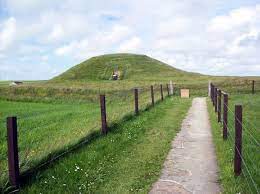Maeshowe: The UK’s doorway to another world

London: For thousands of years, our ancestors found solace in the winter solstice. Today, that belief is still reflected in the astonishing sight of the sun setting on Orkney’s Maeshowe tomb.
Located 10 miles off Scotland’s north-eastern coast, the Orkney islands are a treasure trove of history, from the famous Neolithic village Skara Brae to the hauntingly beautiful Ring of Brodgar – a spellbinding stone circle that was a site of ritual and ceremony. However, when I visited another of Orkney’s famous prehistoric sites, the Maeshowe tomb, my first impression was of an unremarkable green mound surrounded by a ditch.

Despite its appearance, this 5,000-year-old burial cairn is actually a masterpiece of ancient design and engineering, and a testament to the skill of Orkney’s prehistoric residents. That’s because, for around three weeks either side of the winter solstice (which takes place on 21 or 22 December each year), visitors have the chance to see something truly magical occur here.
During this time of year, the narrow passage into the tomb becomes more than just an entrance: it was deliberately designed to align with the setting of the midwinter sun. Just as the last rays start to disappear – which is at around 15:10 at this deepest, darkest time of midwinter – a shaft of light creeps down the passageway, slips across the floor of the tomb and illuminates the back wall like a golden, glowing doorway to another world.
“The winter solstice is a pivotal time of year and Maeshowe represents thousands of hours of backbreaking work,” explained monument manager Phil Hopkins. “If you’re there when it works, when the sun sets at the right time, it’s awe-inspiring. There’s a hushed atmosphere, like when you’re in a cathedral.”
Maeshowe is open year-round, with particular interest around the winter solstice. Due to limited capacity, it is strongly recommended to book a tour online in advance.
Thousands of years ago, Maeshowe would have helped locals cope with the depths of winter. Since it would be dark for 18 hours a day, the startling contrast of the dark tomb being suddenly transformed would reassure them that the days would soon slowly start to lengthen. The light would have reminded them of the re-emergence of life on Earth in spring – and perhaps also the tantalising promise of eternal life in another world.
“It’s a very moving experience but it doesn’t require you to suspend belief. If nothing else, it shows you that you’re in a world that’s turning,” Hopkins said.
Ellie Shiel took a temporary job as a steward at Maeshowe 17 years ago and is still there, endlessly fascinated by the history that unravels around her. “I’ve only missed seeing the winter solstice here twice in that time and that’s because we were closed during Covid,” she said. “The experience is genuinely magical and no matter how many times I see it, it’s always different, with the sun hitting the wall differently and in varying strengths.”
She explained that while they are already fully booked for the 21 December tour, “the beauty of it is that you can come early or late December into January and still see it”.
Three other monuments that align with the sun
Newgrange cairn in Ireland was also built to align with the winter solstice; here the rising sun shines through a small opening in the roof.
Bryn Celli Ddu on the Welsh island of Anglesey is accurately aligned to the summer solstice. As the sun rises on the longest day of the year, sunlight shines directly down the tomb’s passageway to illuminate the chamber within.
Machu Picchu in Peru has a huge stone set at an angle of about 13 degrees northward. Normally the stone casts a shadow throughout the day but at exactly noon on the spring or autumn equinox date, the shadow disappears.
While Maeshowe is among the finest Neolithic buildings to survive in north-west Europe, its construction remains a mystery.
The 10m-long narrow entrance chamber is lined with massive stone slabs, while the central chamber is square and spacious, around 5m across, with huge standing stones – one in each corner – instantly drawing the eye. Some of these would have weighed more than three tonnes, and the effort involved to put them in place was almost unimaginable, especially since any tools were most likely fashioned from antlers. “It would have been such hard work transporting these beautiful huge stones possibly from as far as three miles away,” said Hopkins.
Even the work it would have taken to dig out the ditch surrounding the 7.3m-high and 35m-diameter mound seems improbable. “[The ditch is] 4m deep and carved out of solid rock by people without metal tools. What drove them to keep going, what was the how and why behind this?” Hopkins said.
The site has inspired a range of theories, with most archaeologists and historians believing it was either a place of ritual and religion or an astronomical centre to observe the skies. Humans have always looked to the stars for answers, both for guidance while travelling and to mark the passage of time; while religion and ritual gave cultures worldwide the security of faith, and the people of Orkney would have been no different, likely looking to their gods in the heavens.





